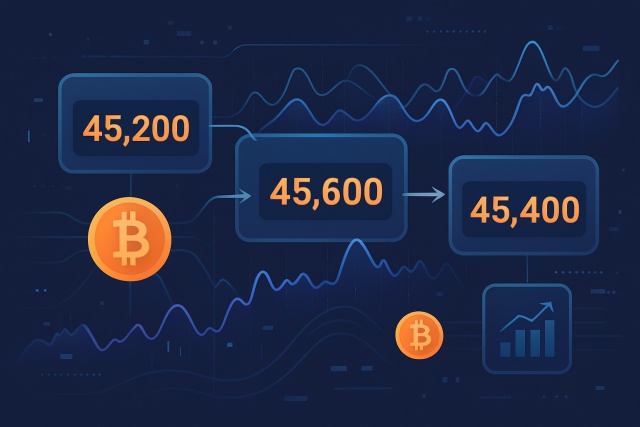Understanding Rational Market Theory In Simple Terms


Rational Market Theory is a cornerstone idea in finance that sheds light on how markets tick, including the whirlwind world of cryptocurrency. At its heart, the theory suggests that market prices reflect all the information out there because people generally try to act reasonably to make the smartest financial moves. This article walks you through Rational Market Theory in a straightforward and approachable way, turning what can often feel like a tangled web into something much easier to wrap your head around—even if finance isn’t exactly your usual cup of tea.
What Exactly Does Rational Market Theory Mean?
Rational Market Theory basically holds that asset prices—think cryptocurrencies or stocks—usually mirror all the information floating around at any given moment. It rests on the notion that individuals in the market are generally pretty rational, striving to rake in gains while dodging losses.
Key terms include 'rational behavior' which means making logical decisions to maximize benefits and 'market efficiency', where prices quickly and accurately reflect all available information.
The Background and Roots of Rational Market Theory
Let's take a little stroll back in time to understand where rational market theory really took root. It’s one of those ideas that’s been tossed around the financial world for decades, shaping how we think about markets behaving logically—most of the time, anyway. This theory isn’t just pulled from thin air; it’s deeply embedded in economic thought and has sparked more debates than a family dinner argument about politics. Understanding its background helps us appreciate why it’s held up for so long, despite the occasional curveball the markets throw our way.
Rational Market Theory takes us back to the mid-20th century when economists began to pin down how markets work and how investors keep a cool, rational head. A game changer was Eugene Fama's Efficient Market Hypothesis from the 1960s. It boldly claimed that asset prices reflect all available information. Fama’s work laid vital groundwork for understanding how rational choices affect market movements.
Financial markets grew increasingly tangled and sophisticated, Rational Market Theory came onto the scene to make sense of traditional markets.
How Rational Market Theory Ties Into Cryptocurrencies (And Why It Might Just Make You Scratch Your Head)
Applying Rational Market Theory to cryptocurrencies brings some unique challenges. The crypto markets are still in their infancy and can swing wildly, making them a rollercoaster ride. There are many players involved from seasoned pros to complete newbies who each have their own take. Blockchain data is out in the open for everyone to see. However, the outside info is often murky and this adds to the tangled web of market dynamics.
- Cryptocurrency markets are still finding their footing and see less involvement from big institutional players than traditional markets.
- Transparency varies a lot between on-chain data and outside news sources.
- The market includes retail investors, speculators and miners, each with unique goals.
- Regulatory uncertainty hangs over the market like a cloud shaping how things move and how confident people feel about jumping in.
- The rollercoaster ride of speculative hype and social media buzz sends prices on wild unpredictable swings.
Crypto markets feature rational participants aiming for profit, but their behavior often dances to a different tune than what you’d expect in traditional markets. Some are chasing speculative momentum rather than the underlying value, while others lean heavily on on-chain data to steer their decisions. This mix results in prices that reflect a cocktail of careful evaluation spiced up with emotional and social influences, making crypto markets uniquely dynamic.

Common Misunderstandings About Rational Market Theory That People Often Miss
Many people tend to assume that Rational Market Theory means markets always act like perfectly tuned machines responding instantly and logically to every new piece of information. In reality, markets are much messier than that. They’re swayed by emotions and the slow spread of information as well as irrational behavior, leading to those all-too-familiar hiccups like brief mispricings and bubbles.
- Markets often give us a sneak peek at future prices but they’re far from crystal balls.
- People usually let emotions or biases sneak into their decisions rather than sticking to cold hard logic.
- Market bubbles and crashes are like drama on a financial stage showing how wildly irrational things can get.
- Not everyone’s working with the same toolkit because access to and understanding of key info varies.
- Cryptocurrency markets tend to dance to their own tune and don’t always play by usual market rules.
A Closer Look at the Impact of Rational Market Theory on Investment Choices
Investors and traders often lean on Rational Market Theory as the bedrock of their game plan, zeroing in on the info that is already on the table rather than trying to guess what the market might do next.
Dive deep into every bit of data you can get your hands on related to an asset. It’s like looking under every rock before making a move.
Current prices usually already include most of this info, so don’t be fooled into thinking it’s all fresh news.
Base your buy or sell decisions on truly new insights or clear shifts you can’t ignore. Otherwise, you’re just chasing shadows.
Spread out your holdings. Think of it as not putting all your eggs in one basket because that usually helps keep risk in check.
Keep an eye on the overall market mood. Sometimes emotions run wild and can push prices to extremes or kick off trends, so it’s better to be prepared than caught off guard.
For cryptocurrency investors it’s really about zeroing in on reliable info like blockchain metrics and adoption trends and the latest updates on regulations while steering clear of hype-fueled speculation that can easily lead you astray.
Challenges and Critiques of Rational Market Theory A Closer Look
Rational Market Theory plays a key role but has its fair share of limitations. Research in behavioral finance shows investors don’t always play by the rules. They often behave irrationally because of biases, emotions or faulty information. This pushes markets far from the idea of perfect rationality and leads to anomalies, inefficiencies and the wild unpredictable swings we expect.
These limitations really come into sharper focus in cryptocurrency markets. The hype cycles and wild price surges whipped up by social media buzz highlight how emotions and herd mentality push prices far from rational ground. Lightning-fast sell-offs also show this clearly.
"Even when we’ve got deep knowledge tucked under our belts, nailing down exact market movements remains a real challenge, because human psychology and those curveball, out-of-the-blue events tend to throw logic right off track." – Nobel Laureate Robert Shiller
Understanding Rational Market Theory and Behavioral Market Theory with a Friendly Dive
| Aspect | Rational Market Theory | Behavioral Market Theory |
|---|---|---|
| Assumptions about Actors | Investors are presumed to act in a fully logical way, basing their choices strictly on the facts at hand | Investors often get caught up in their feelings and cognitive quirks, making decisions that are less than perfectly rational |
| Market Efficiency | Markets are viewed as quick to absorb every scrap of available information, leaving little room for surprises | Markets can be a bit messy and inefficient at times, thanks to the whims of human irrationality |
| Predictability | Prices are thought to reflect the true fair value, so beating the market is no easy feat | Prices can wander off from their true worth, which offers a chance for some savvy players to exploit these mispricings |
| Examples | Stock prices that snap into place right after earnings announcements | The wild swings of market bubbles, crashes, and chasing trends driven by momentum |
| Implications for Investors | Encourages a mostly hands-off, passive investing style focused on the long haul and solid data | Suggests paying attention to psychological factors and the overall mood of the market, because numbers don’t tell the whole story |
Getting to know both Rational Market Theory and Behavioral Market Theory really helps paint a clearer picture of how cryptocurrencies and other assets trade. Rational models do a solid job explaining many price movements, but it’s those behavioral insights that often shine a light on the quirks and surprises that catch everyone off guard.
Key Takeaways on Rational Market Theory
- Markets are thought to weave all the info they can get into asset prices, making them like a big noisy rumor mill that surprisingly gets most things right.
- Participants generally try to keep a cool head and push price changes to mirror cold hard facts and sound logic.
- Cryptocurrency markets share some DNA with traditional ones but dance to their own tune due to wild price swings and a colorful cast of players.
- Real decisions often get tangled up in human emotions and quirky biases.
- Blending rational analysis with behavioral insight gives investors the best map for navigating these confusing and unpredictable markets.
Frequently Asked Questions
Does Rational Market Theory mean cryptocurrency prices are always accurate?
No. Rational Market Theory suggests prices reflect all known information but crypto markets often throw logic out the window with irrational behavior or wild speculation. Prices can wander from what we call 'rational' for a bit because of emotions, hype cycles or uneven access to information.
How can I apply Rational Market Theory to my crypto investments?
It’s a good idea to ground your decisions in solid data like blockchain activity, adoption trends and regulatory updates rather than chasing every short-lived buzz. Spread your bets and assume prices mostly reflect common knowledge. Then tweak your strategy only when fresh meaningful info lands on your desk. Using tools like on-chain analytics can be a real lifesaver in keeping emotions from steering the ship.
Why do crypto markets sometimes seem irrational if participants are supposed to act logically?
While Rational Market Theory paints a picture of individuals acting with laser focus and logic, the crypto world is messier. It includes a mix of players—speculators, newbies and the occasional FOMO-driven trader—who let emotions or the latest social media frenzy guide their moves. Add in lower institutional presence and patchy regulations and you get volatility spikes that send the market off its rails for a while.
What’s the difference between Rational Market Theory and Behavioral Finance?
Rational Market Theory assumes people make decisions with a cool head and logically weigh all available info. Behavioral Finance flips the lens and focuses on how emotions, biases and slip-ups muddy the waters. Both have their place—rational models help us understand broad long-term trends while behavioral finance offers a handy map for navigating wild short-term rides like crypto bubbles or panic sell-offs.
Can Rational Market Theory predict crypto price crashes or rallies?
Not quite. The theory lays out how prices should behave in a perfectly logical market but reality tosses in surprise events, herd mentality and misinformation that throw a wrench in the works. It can signal when assets look too pricey or undervalued but with crypto’s notorious ups and downs, any prediction is more of an educated guess than a crystal-clear forecast.
Useful Links
- Investopedia - Your Go-To Hub for Financial Education and Market Insights
- Eugene Fama's Research at the University of Chicago - Where Market Efficiency Got Its Backbone
- CoinDesk - Staying Ahead with News and Analysis on Cryptocurrency Markets
- Nobel Prize in Economic Sciences - Honoring Breakthroughs in Market Efficiency Research
Start Your Crypto Journey with Coinbase Today
Ready to enter the cryptocurrency market but unsure where to begin? Coinbase makes buying, selling, and storing digital assets simple and secure for beginners and experts alike.








